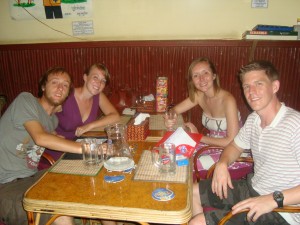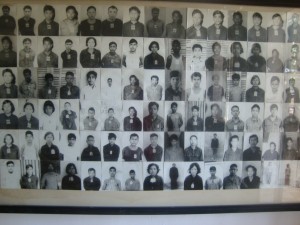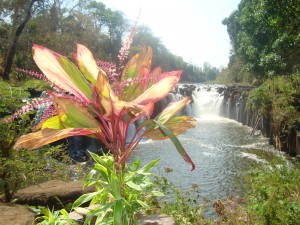It’s always exciting to enter a new country, to see how it varies from the one you just left. On first impressions Cambodia looked the same as Laos; with the same wooden shacks on stilts and the same cavalier attitude to road travel – we were ferried to Phnom Penh in 3 different vehicles, one of which was a rusty old Toyota car! But when we got to the city we could see that there was a marked difference. It was chaotic and noisy, odorous and clamorous, skyscrapers and industrial chimneys once again invaded the landscape, and once again we were exhorted to buy something, anything, every 2 yards. Although it sounds a little too much like Bangkok, it somehow wasn’t, and we really liked Phnom Penh. (Perhaps the slight drop in temperature may have something to do with our new found enthusiasm for cities.)
 Anyway, the reason we came to Phnom Penh was to visit Stul Treung and the Killing Fields. These are sites which the Cambodians have maintained as a vivid testimony to the genocidal regime of Pol Pot and the Khmer Rouge in the hope that, by remembering and showing the rest of the world, the same thing will never happen again.
Anyway, the reason we came to Phnom Penh was to visit Stul Treung and the Killing Fields. These are sites which the Cambodians have maintained as a vivid testimony to the genocidal regime of Pol Pot and the Khmer Rouge in the hope that, by remembering and showing the rest of the world, the same thing will never happen again.
Stul Treung was once a school in the centre of Phnom Penh. It was converted into a prison by the Khmer Rouge and re-named S-21. Outside there were some living victims of the Khmer Rouge, maimed and disfigured beggars clamouring for money. Once inside, we were greeted by hundreds of black and white photos, the haunted faces of the detainees of S-21, the majority of which were tortured: hacked, bludgeoned, beaten and electrocuted. Those that survived were subsequently bussed to the Killing Fields.
It was chilling to realise that you’re standing on the same grubby floor on which these atrocities happened, looking at the same iron bedsteads that those cadaverous faces were manacled to each night before a fresh bout of terror each morning. Such was the gravity of the place that everyone walked round separately in a reverent, bewildered silence. There was also a museum there which gave a history of the Khmer Rouge revolution, its breathtaking brutality – over 2 million killed – and its infuriating hypocrisy. An example being the fact that anyone with an inkling of intelligence was mercilessly slaughtered, yet Pol Pot himself was educated at a Parisian university.
After Stul Treung we visited the Killing Fields, about 10k outside of Phnom Penh. Whilst not as emotionally stirring as the prison – perhaps because it was outside and the sounds of children playing in an adjacent school floated by – it was still gruesome. There were hundreds of bunkers which were once mass graves, a macabre temple of human skulls that had been excavated, and a wizened tree against which children and babies were bashed to death.
Whilst it must be difficult for them, the Cambodians have done an admirable thing in retaining these two sites as a stark reminder of a brutal all-too-recent past. You have to admire their spirit, and the way they have rebuilt the country in the wake of such tragedy; although you do find yourself looking at middle-aged men, imagining the iniquities they must have witnessed, and were they victims or perpetrators?


